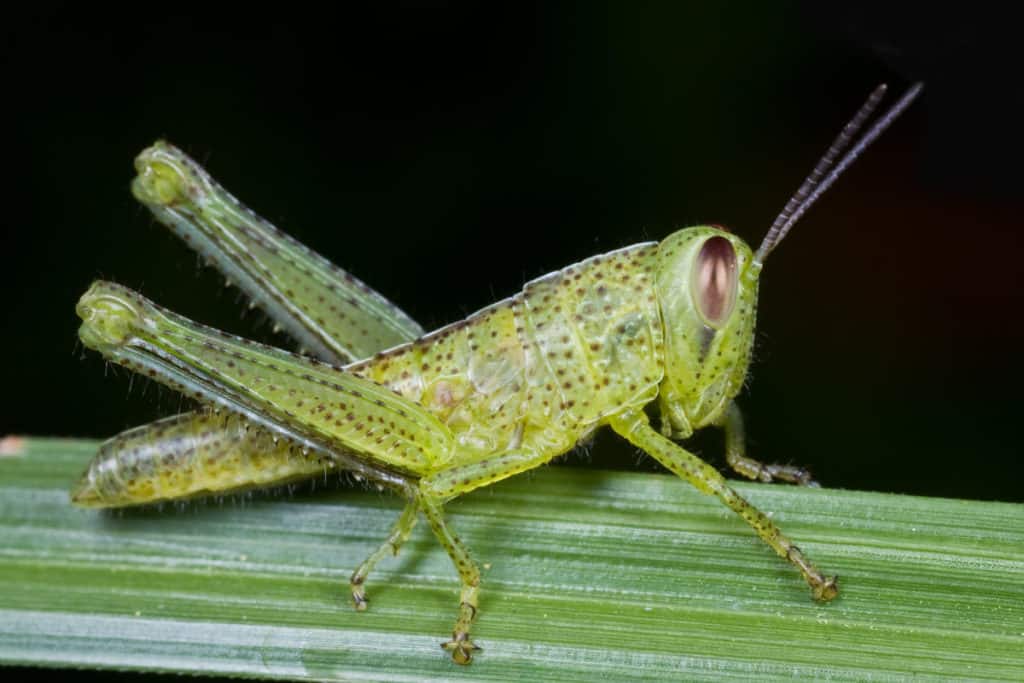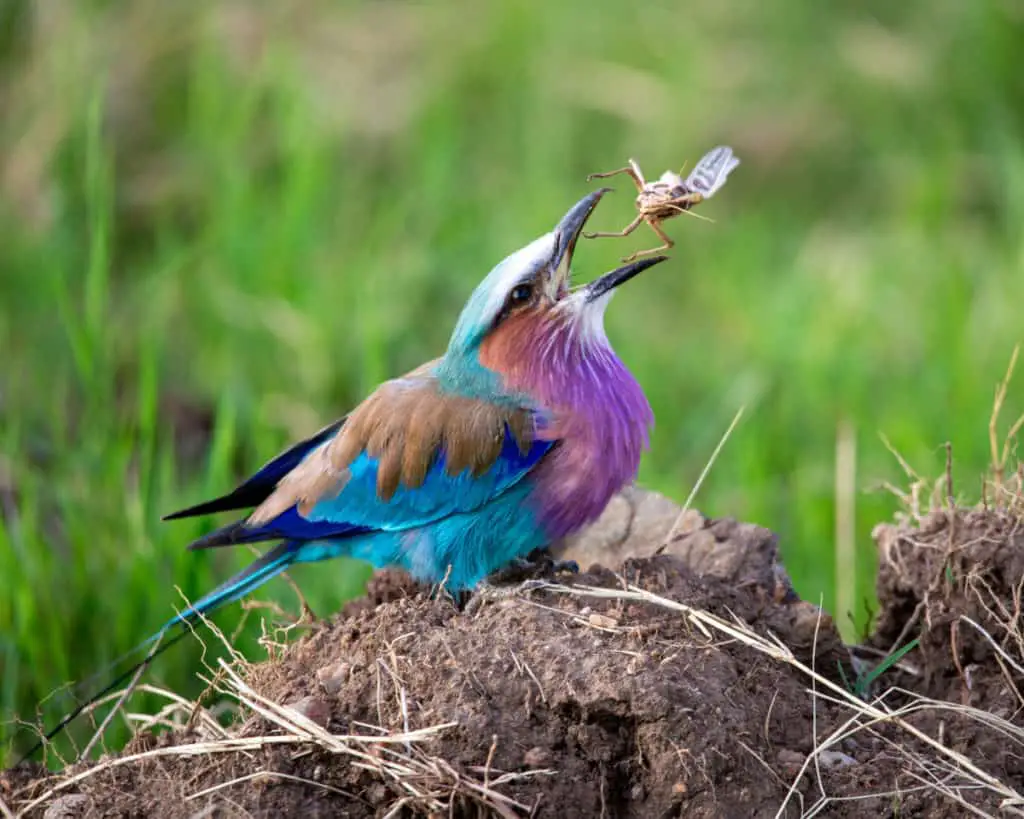Sometimes a hated insect by farmers and gardeners because of their plant destroying capabilities, grasshoppers are incredibly interesting insects.
Grasshoppers are metamorphic insects, with an average 12 month lifecycle with egg, nymph, and adult stages. The egg stage is up to 11 months depending on the climate. The nymph stage is 5 to 6 weeks including 5 to 6 molts. Adults live 1 to 2 months, within 1 to 2 weeks lay eggs every 2 to 3 days.
Keep reading to find out more about the grasshopper’s life cycle, the factors that limit their life (some of these might surprise you), and the different types of grasshoppers that you might find in your garden.
What Does A Grasshopper Look Like?
Grasshoppers are flying insects that closely resemble the appearance of a cricket.
These flying and jumping insects belong to the Orthoptera order in the suborder of Caelifera.
Although they have wings and can technically fly, most (but not all) grasshoppers do not fly, but sort of flutter to different locations, somewhat like a chicken.
If you are interested we have an entire article about how and why grasshoppers fly, it’s called, Can Grasshoppers Fly?
One of the most common traits of a grasshopper is its ability to jump. Grasshoppers have powerful hind legs that are used to catapult them up to 25cm high and for as far as a meter.

With a size ranging from 1 – 7cm (sometimes up to 15cm) some grasshoppers, depending on the species can jump more than 20 times their size.
This ability is of utmost importance to the survival of a grasshopper as it allows them to avoid their predators.
Grasshoppers vary in color from a mixture of browns, reds, and greens but yellow and pink pigments also occur naturally.
Grasshoppers, like other insects, have six legs, a pair of wings, antennae, a head, abdomen, and thorax.

Once again, the weight will depend on the species, but on average is approximately 300mg.
It is also worth noting that female grasshoppers are larger than males.
Grasshoppers have a hard exoskeleton and are cold-blooded, meaning they need to sit in the sun/shade in order to regulate their body temperature.
The Life Cycle Of A Grasshopper
As mentioned above, a grasshopper’s life cycle is split into three stages. The egg, the nymph, and the adult.

This is different from many insects, as the majority of them go straight from egg to adult form or have a full metamorphosis which includes larvae and pupae.
Because grasshoppers change their form through their life cycle they are known as metamorphic insects.
A full life cycle for a grasshopper is approximately 1 year, although an adult grasshopper does not live much longer than 1 – 2 months.
The Grasshopper Egg
Fertilized female grasshoppers lay their eggs in mid to late summer when temperatures are the warmest. This allows enough time for the eggs to develop before the weather turns cold.
Depending on the species the females will lay eggs at the bottom of plant stems and the underside of leaves.

In other species of grasshopper, the female will lay the eggs approximately 2cm – 5cm under the soil or Here she will deposit a semi-solid substance that is used to set and form an egg pod.

In some species the female will also use a glue-like substance between the eggs to bind them, however, this is not true for all grasshoppers.
Once the eggs are bound, the female secretes more of the foam-like, semi-solid substance on top of the eggs as a cap for the hole, or to bind them to the leaf or stem.
A female grasshopper can lay between 200 – 400 eggs, split between up to 25 different pods.
Here, below the soil, or safely contained in their pods, the eggs will remain throughout the autumn and winter months until the following warm season.
Eggs, especially in a colder climate can spend up to 10 months under the soil before hatching.
This leaves only 2 months from the full 1-year cycle for the grasshopper to develop from a nymph to an adult, as well as mate and reproduce.
If you are interested in looking at the egg-laying stage of the grasshopper lifecycle in more detail check out this article we have written about the topic, Do Grasshoppers Lay Eggs?
The Nymph Grasshopper
Grasshoppers do not go through a full metamorphosis. There is no larva stage in their change and therefore only an incomplete metamorphosis takes place.
The Grasshopper nymphs are an exopterygote (hemimetabola) which means that they resemble a small version of a fully grown adult.

Nymphs differ in four major ways to mature adult grasshoppers:
1. They are much smaller
2. They are lighter in color
3. They are wingless
4. They do not possess reproductive organs
After emerging from the eggs, the nymphs (known as molts) will start feeding on soft leaves and succulents within the first day.
During this stage of their life cycle, the molts will undergo a number of physical changes as they move towards being adults.

These changes are known as instars. A molt will undergo 5 – 6 instars before becoming a fully grown adult grasshopper.
Each instar is characterized by the shedding of the cuticle skin as well as the gradual growth of wings.
A grasshopper nymph will remain in this stage for approximately 5 – 6 weeks before becoming a mature adult grasshopper.
We do have an entire article dedicated to a grasshoppers’ molting process. If you are interested you can check it out here, Do Grasshoppers Molt?
The Adult Grasshopper
After 25 – 30 days, the wings would have fully developed and the nymph will become a fully mature adult.
Adult grasshoppers are more mobile and agile than nymphs, which is a characteristic that aids them in hunting and escaping predators when they sense they’re near.
The reproductive organs will be fully developed after the first month of emerging from the egg and the male and female grasshoppers will become fertile.

However, a female grasshopper does not lay eggs for the first 1 or 2 weeks which allows them to feed and gain enough weight before laying her eggs.
Once she starts laying her eggs, she will continue to do this in intervals every 2 – 3 days until she dies.
The time from the egg being laid until the start of the adult grasshopper life is approximately 11 months.
Each adult will live for only 1 – 2 months before dying, depending on the weather.
Even though the full lifespan of a grasshopper is 12 months, there is only a 50% chance that, after emerging from the egg, the insect will make it through adulthood.
This is because of the large number of predators and human intervention that takes place.
What Are The Main Causes Of Death For Grasshoppers?
As mentioned above, grasshoppers have only a 50% chance of survival after leaving the egg because of their predators. However, human intervention and climate also play a large role in their lifespan.
Grasshopper Predators
Birds
Birds are one of the largest predators that grasshoppers face. Some of the birds that are included in this are blue jays, blackbirds, chickens, bluebirds, and hawks.

Mammals
When hiding and grazing in flowers like dandelions, grasshoppers fall prey to mammals such as raccoons, possums, bats, shrews, and other rodents. Some monkeys will also eat grasshoppers if they are given the chance.

In some countries, grasshoppers form a staple part of the human diet, while in others they are seen as a delicacy.
Reptiles, Amphibians, And Fish
When a grasshopper’s habitat is around a water body they fall prey to frogs, toads, and turtles. If a grasshopper is located too far over the edge of a water bank (sitting on long grass), they are also fed on by fish such as bass.

Some snakes such as the northern ringneck snake have also been known to feed on grasshoppers.
Insects
Chinese mantis and other larger insects hold another threat towards grasshoppers. Other insects that feed on grasshoppers include dragonflies, some bee species, hornets, spiders, and ants.
Interested to know how a grasshopper compares with a praying mantis? Maybe? Then check out this detailed comparison we have done between the two insects, Grasshopper Vs Praying Mantis

Fungi
Grasshoppers are even attacked by some fungi. The Entomophthora grylli is a fungus that affects grasshoppers when they climb onto an infected plant.

The fungi freeze their motor functions and cause them to grip onto the plant without being able to let go. Here the grasshopper dies as the fungi slowly spread throughout its body.
Human Intervention
As grasshoppers are seen as major garden pests and a large destroyer of farms, many pesticides are used to prevent them. Some of these chemicals are sprayed on the ground to kill the eggs, while others are used directly on plants.
Another major threat to the grasshopper population is wildfires and invasive agriculture, which threatens over a quarter of the grasshopper population in Europe.
Different Types Of Grasshoppers
There are more than 10,000 different species of grasshopper and thousands more that have not been classified. Each of these species is unique in its location, anatomy, and behavior trends.
Although each has a specific scientific name, here are a few with common names that you might find in your garden or around your house:
Brown-spotted Grasshopper
Found throughout the midwest region of the United States, this grasshopper gets its name from the brown spots found all over their bodies.

The Brown-spotted grasshopper feeds primarily on grass and sedge.
Clear-winged Grasshopper
Feeding on small grasses and grains, this grasshopper is considered to be one of the most destructive species.

Found in abundance along the west coast and north-eastern regions of the U.S, this little plant destroyer can be identified by its green color and clear wings.
Four-spotted Grasshopper
Notable because of its green body and yellow, black, and pink/red spots, this grasshopper is another native to the midwest region of the United States.
The Four-spotted grasshopper can usually be found in areas abundant with buffalo and blue grama grass.
Green-striped Grasshopper
Found in abundance in both North America and Central America, this grasshopper is unique in its diets. The Green-striped grasshopper prefers to feed on succulents instead of leafy greens and grass.

Grasshoppers Are In Two Main Types
Furthermore, grasshoppers can be separated into two main types: Long-Horned Grasshoppers and Short-Horned Grasshoppers.
Long-horned Grasshoppers
Long-horned grasshoppers are easy to identify from their long antennae. These antennae can span approximately the same length as the grasshopper’s body.
Short-horned Grasshoppers
Short-horned grasshoppers, which are often called Locusts, have shorter antennae, which are usually less than half their body length.
These species of grasshoppers are often the ones responsible for large crop destruction when they migrate, as they do so in swarms.
Do you live in Flordia? We have a detailed article on the Grasshoppers you will find in Flordia if you are interested, Grasshoppers In Florida: Your Complete Guide.
The Wrap Up
Scientific Classification
Kingdom – Animalia.
Phylum – Arthropoda.
Subphylum – Hexapoda.
Class – Insecta.
Order – Orthoptera.
Suborder – Caelifera.
Grasshoppers are classified into two main types, although there are over 10,000 different species.
The full life cycle of a grasshopper is around 12 months, however, they will rarely live throughout the entire cycle.
A grasshopper goes through a three-phase incomplete metamorphosis that includes the egg, the nymph, and the adult stage.
During this time only 1 – 2 months of the lifecycle will be spent outside the egg and approximately 1 month will be spent as an adult.
Grasshoppers are unique insects and are born in abundance due to their many natural predators.
With their hard exoskeletons and crop-destroying capabilities, these insects are a true wonder that is worth paying attention to.
Sources
https://www.sciencedirect.com/science/article/abs/pii/0022201168901559
https://www.britannica.com/animal/Exopterygota
https://www.amentsoc.org/insects/glossary/terms/incomplete-metamorphosis
https://extension.umd.edu/learn/grasshoppers-life-cycle-and-control
http://faunaofindia.nic.in/PDFVolumes/records/055/01-04/0029-0068.pdf
https://onekindplanet.org/top-10/top-10-worlds-highest-jumping-animals/#:~:text=Grasshopper,as%20long%20as%20basketball%20court!
